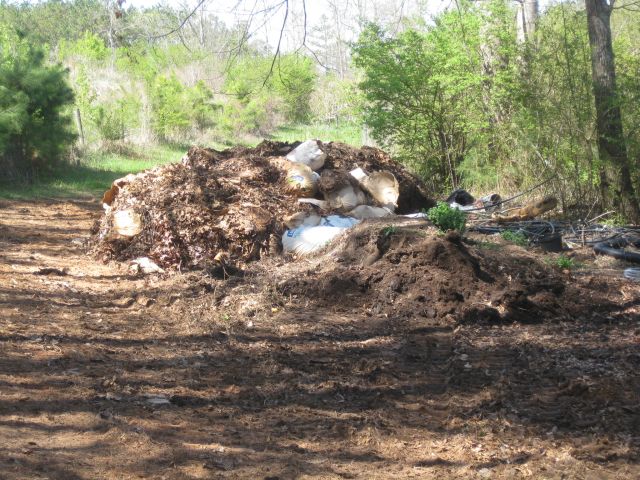Caution – this is a long tale and will only be of interest to those who have similarly suffered from malfunctioning engines!
In my November 25 post I described how I replaced the starter and that the bobcat started fine but then would not switch off. Sporadically during the subsequent months I tried diagnosing the problem but it was only with the return of spring and serious bobcat chores awaiting, that I focused on the issue. The immediate bobcat task was turning and consolidating my 100 plus leaf bags so the composting process could advance.

Diagnosing why the diesel engine would not switch off was not easy and I tried various remedies which were a waste of time. With hindsight I should have considered events preceding the problem and methodically eliminated the possibilities.
For example I thought the problem might be a faulty ignition switch. I had installed a new replacement switch a couple years ago and it had 5 terminals and should have had 6 but I satisfied myself at the time that 5 would be fine based on the wiring diagram. And it did work fine until I replaced the starter motor and the engine would not turn off. Logically therefore the ignition switch had nothing to do with the problem and there was no need to order a new 6 terminal ignition switch.
So with new switch and re-charged battery and partially refilled diesel tank I tried starting up the bobcat. After a brief period of turning, it started – delay probably the pumping of diesel to the engine which I had run dry in November. But now in the on position there was a whining noise which was the starter not disengaging. In the off position the whining stopped but the engine kept running. To switch it off I had to turn the emergency shut off knob near the carburetor clockwise to the stop position.
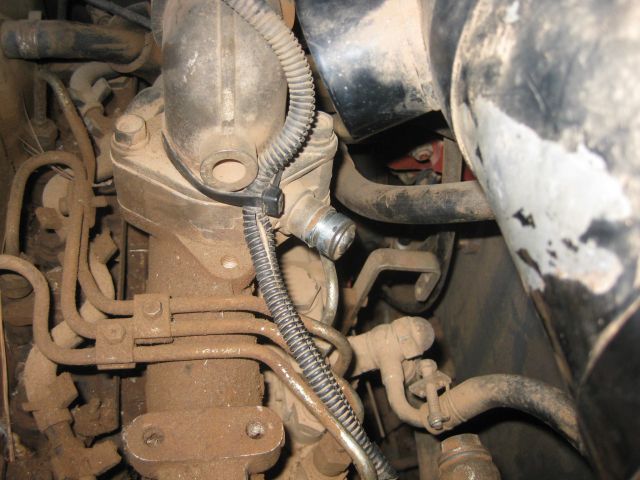
It took some time before the engine strangled to a stop with a lot of black smoke coming out which made me think of oil being burnt, not a good way to stop the engine.
So now I had a new problem – starter not disengaging after the engine was running. I checked a lot of wiring and re-examined the connections to the starter, to no avail. The only conclusion I could come to was that I had incorrectly wired up the new ignition switch. The light green red wire (LGR) at the ignition switch is the wire which switches on the starter motor. Could the LGR be connected to the wrong terminal at the ignition switch – should be C terminal. Worth checking.
I pulled cab forward, disconnected battery cables, pulled cab back, opened control box and examined wires at ignition switch and yes I had mixed (LGR) light green red with (GR) green red. Crazy I should have made such a silly mistake, but the wires are old and discolored. I corrected the mistake, pulled cab forward, reconnected battery cables and started and it started ok and no whining from starter BUT it still did not switch off at ignition and fortunately this time just shuddered to a stop. At least I had corrected a fundamental mistake through logical analysis which made me feel better about my chances going forward.
I tried restarting the engine. The engine turned ok but now would not start. Seems no fuel getting to the combustion chambers. I now had a new problem – a fuel problem – how to bleed the fuel lines. A nice thing about Takeuchi is that the operator’s manual (but not the workshop manual) is available for online download. The operator’s manual referred to a manual pump located near the fuel injection body. It is hidden from view but I managed to locate it, and after turning clockwise to free it I pumped several times until diesel emerged at the top. I tightened it (clockwise) and the bobcat started easily and seemed to switch off at the ignition key but a second try had it continuing to run. So I still had a problem with being unable to switch off the engine and the fact it shut down once at ignition but not a second time indicated some intermittent failure.
I decided to do some internet research. Apart from some vehicles which have a vacuum switch-off like the Mercedes, it seems most diesel engines have a fuel shut off solenoid. The solenoid can cut off the fuel by either pushing or pulling on a protruding pin/shaft. From this point on there are many mind confusing possibilities:
- the action of the solenoid can be to push or pull on the shaft, and when the solenoid is not acting, the position of the shaft will be determined by a spring in the solenoid ;
- one process could be that when the solenoid is not activated and the shaft is positioned by the spring then fuel does not flow, and activating the solenoid moves the shaft against the pressure of the spring and fuel flows. Deactivating the solenoid permits the spring to return the shaft to original position which cuts off fuel flow.
- or fuel flows when the shaft is held in position by the spring, activating the solenoid cuts off the flow for a short period of time which shuts down the engine and then with engine off the spring returns shaft to fuel on position.
- there are 3 wires to solenoid – 1 is earth, 1 is direct from battery and 1 is from ignition switch. Another possibility is the wire from the battery activates the solenoid all the time and the wire from ignition via a relay deactivates the current from the battery. This would mean the solenoid is continuously powered which is wasteful. So I rejected this possibility (I also found later that when engine is off, the solenoid spring positions the shaft).
- If wire from ignition switch via a relay connects wire from battery to solenoid to power it then it would seem that when wire from ignition is switched off then power from battery will be off and engine will shut down. But engine was not shutting down when wire from ignition was switched off! This didn’t make sense – instinctively I felt the problem was there was intermittent failure of the wire from the ignition switch to the solenoid and this wire had to be intact to switch off the solenoid. The logic doesn’t really hold for example if the wire was interrupted then the engine should shut down but it was continuing to run (perhaps some kind reader can explain this for me). Nonetheless, a break in the wire was what I would look for.
I thought it was about time I found the solenoid. On the web I saw images of what the solenoid for Takeuchi should look like – a round device with 3 wires emerging from the rear and a movable pin on the other side and it should be connected to the fuel body. I spent a lot of time looking for the solenoid both visually and feeling with my hands for any wires coming out of the fuel injector body. And I couldn’t find it even with my inspection mirror and there was nothing in the workshop manual showing where the solenoid was attached to the fuel injector body. I still had the access cover off from underneath the Takeuchi so I looked from underneath and there it was – it was located near the bottom of the engine with a long shaft running vertically to near the fuel injection body.
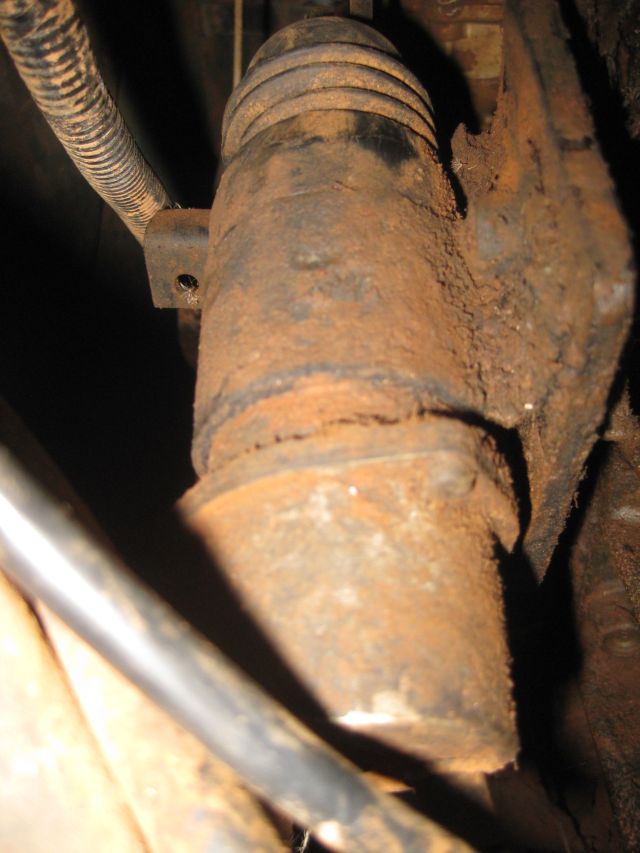
One suggestion had been that the solenoid might have jammed in the on position so I moved the shaft up and down and it was in the up extended position held there by a spring in the solenoid housing so therefore the solenoid had not jammed and presumably did not have to be replaced. The wires to the solenoid were located below the starter motor and I had quite likely pushed against these wires as I removed the old starter and maneuvered the new one into place. But again, if a wire had disconnected then the engine wouldn’t start and my problem was that it started but wouldn’t switch off. When I purchased the machine I noticed that someone had run a red wire from the cab control panel down to the innards of the engine. I now saw that the red cable was attached to one of the solenoid wires. Why?
So I decided to investigate the red wires. I loosened the instrument panel box and saw the 2 red wires coming in and they headed to a push button.
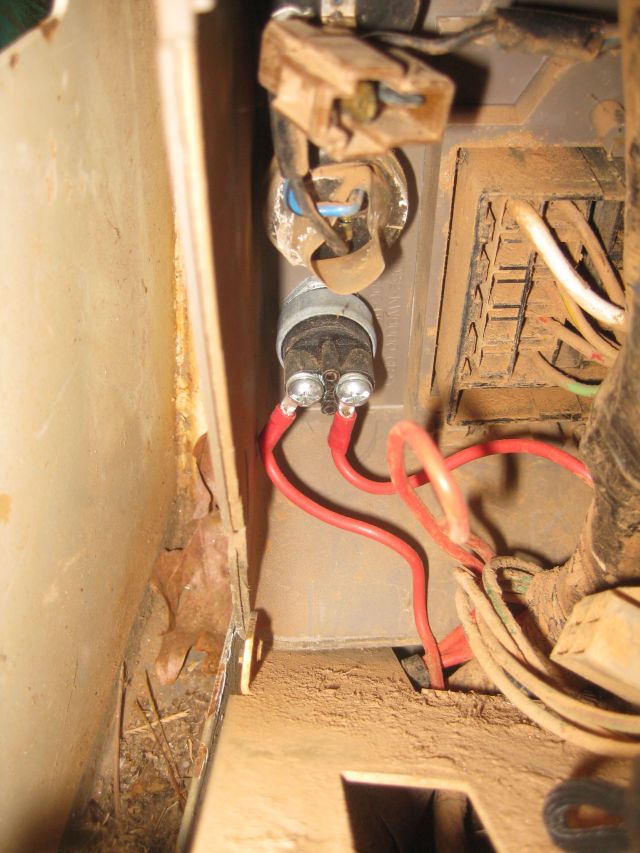
With a voltmeter/continuity tester I established that the push button was normally open which means when you press the button the circuit closes. So the red wires had to do with the shut off solenoid and the circuit was open until the button was pushed.
I figured that engine shut off must have been a problem for the previous owners and they had this circuit rigged to shut down the engine which I vaguely recalled the dealer telling me about. So, thinking I had found the solution I started the engine then switched off the key and it kept running, then pressed the button and it kept running. Then, thinking the key had to be on for the switch to work I turned the key to the on position and pressed the button and the engine kept running. I was pissed. I tried switching it off by turning the shut off button above the injector but this time it ignored me. I did not want it to run dry as I did last time and then it occurred to me – why not get under the engine and pull on the shaft from the solenoid. I work by myself so if something goes wrong there is no one to hand which is a sobering thought. But what could go wrong? So under the engine I went and via the access gap I reached up, found the vertical shaft from the solenoid and pulled down on it and the engine promptly shut down.
So the push button added to the control panel was not shutting down the engine. Back under the bobcat I went to the access hatch and carefully studied all the wiring leading to the switch solenoid. And then I saw it – what appeared to be a break in the insulation of the LGR wire which I must have caused when I worked on the starter.
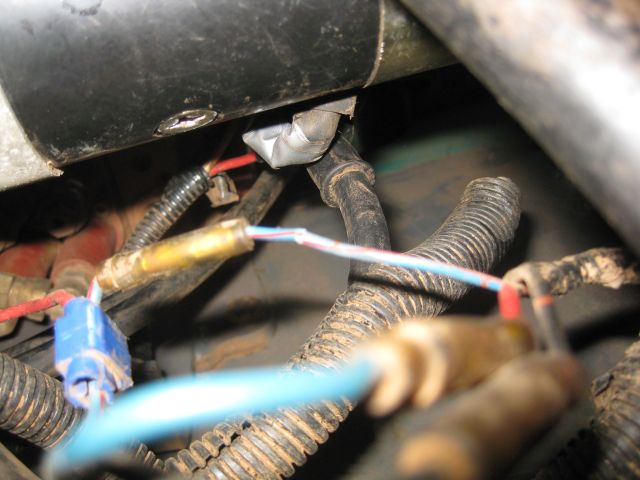
Perhaps the break in the wire was more than insulation but some of the strands as well. This would explain why sometimes it did or did not shut down. There is very little space under the bobcat and I could only effectively use one hand. I snipped the wire at the break and tried splicing it but it was too high up to do effectively with one hand. Eventually after a lot of back and forth I added 3 connectors.

The fix seemed to work – the engine shut down at the ignition switch! Now to re-attach the access cover. But this also was not straight forward – it did not go back into place. I recalled that when I undid the cover it seemed to spring out. So the cover or the port into which it fitted was out of shape. And force would be required to get it back into position. My tractor bottle jack was too large but I found my pickup jack would fit and so with this smaller jack I raised the cover. But it came up .5″ out of line with the bolt holes. After several attempts of raising, trying, lowering, adjusting and raising I got it right.
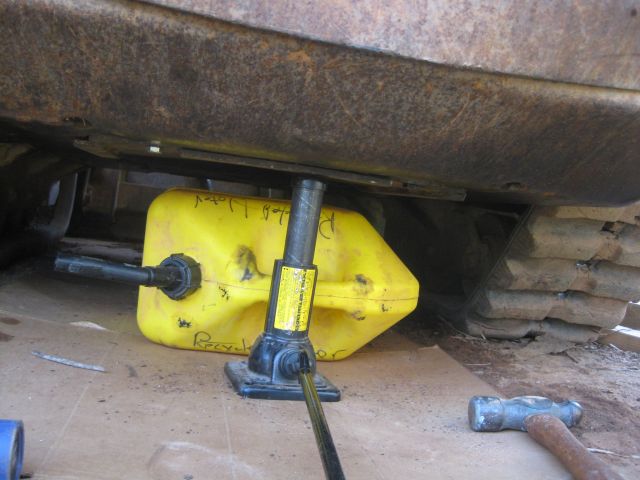
With all this done I cleared the tools, started the Takeuchi, and consolidated the compost heaps. And when I was finished and the bobcat was back in its berth, the engine did turn off!
